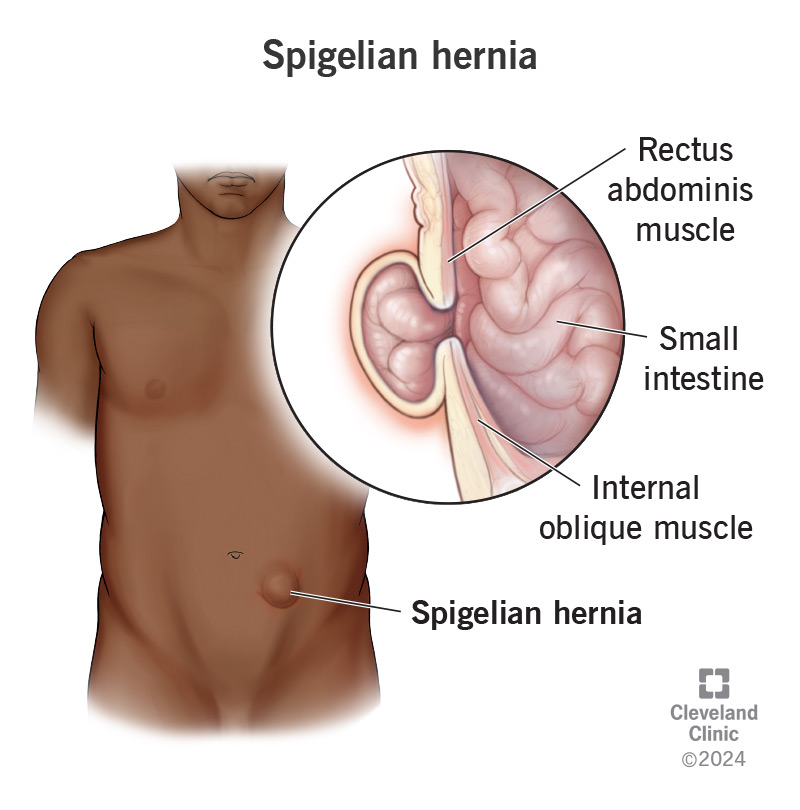A Spigelian hernia is a hernia in your lower abdominal wall. Hernias happen when organs push through tissue that separates certain abdominal muscles. The hernia may cause a bump or lump in your lower belly or belly pain. Large Spigelian hernias can cause serious complications. Treatment is surgery to repair the hernia.
Advertisement
Cleveland Clinic is a non-profit academic medical center. Advertising on our site helps support our mission. We do not endorse non-Cleveland Clinic products or services. Policy

A Spigelian (Spuh-gay-lee-an) hernia happens when a part of your intestines pushes through the tissue that separates your front abdominal muscles. The hernia makes a lump or bump in your lower belly.
Advertisement
Cleveland Clinic is a non-profit academic medical center. Advertising on our site helps support our mission. We do not endorse non-Cleveland Clinic products or services. Policy
Small Spigelian hernias may not cause painful symptoms. But large Spigelian hernias can cause serious medical issues. For example, a hernia may grow large enough to block your intestine. Or it may cut off the blood supply to your intestines (strangulated hernia). Healthcare providers may call this condition a lateral ventral hernia.
One common symptom is a bulge or lump below and 2 to 3 inches to the side of your belly button. The bump or lump appears when you stand up and goes away when you sit or lie down. But a Spigelian hernia may not cause symptoms. Other symptoms are:
Spigelian hernias happen when specific abdominal muscles are weak. Those muscles are your transversus abdominis and internal oblique muscles. Those muscles may weaken as you age. This makes it easier for your large or small intestines to slip through the tissue that separates these muscles. Pregnancy may also weaken your abdominal muscles.
Medical issues that put pressure on your muscles may cause Spigelian hernias. Those conditions include:
Advertisement
You may develop a Spigelian hernia if you’re hit in your lower belly. Healthcare providers may call this a traumatic Spigelian hernia.
A Spigelian hernia may cause complications like:
These more serious issues may cause the following symptoms:
If you have these symptoms, call 911 or go to the emergency room.
A healthcare provider will do a physical examination. They’ll examine your lower belly. They may ask you to stand up or stretch while standing. They do that so they can check for a bulge in your lower belly that goes away when you sit down.
They may guide you through a Valsalva maneuver. This procedure causes internal pressure on your belly. That pressure may cause a bulge or lump. In a Valsalva maneuver, you take a breath, push out air with your mouth and nose closed and push down as if you’re pooping.
Healthcare providers may do imaging tests like computed tomography (CT) scans or an abdominal ultrasound. They may do a laparoscopy to confirm a Spigelian hernia diagnosis.
Hernia repair surgery is the most common treatment. In Spigelian hernia repair surgery, a surgeon pushes your intestine back into place and repairs the hernia. Hernia repair surgery may be open, laparoscopic or robotic hernia repair surgery. Your surgeon will discuss your options.
Hernia surgery, like all surgeries, may cause complications like:
If you’re like most people, surgery to repair the hernia takes care of the issue. But you may need additional surgery if the hernia causes complications.
It’s possible to develop another Spigelian hernia. You should contact your provider if you have symptoms like severe belly pain or a spot in your lower belly that’s painful to touch.
Advertisement
There’s a lump or bump in your lower belly. It’s a bit odd because it doesn’t hurt when you poke it with your finger. And you only see it when you’re standing. But that mysterious lump could be a Spigelian hernia — and a reason to talk to a healthcare provider. Spigelian hernias can cause serious medical issues. Surgery to repair the hernia reduces the risk.
Advertisement
Hernias can be painful – Cleveland Clinic’s experts can help. We are leaders in minimally invasive hernia repair, and abdominal wall reconstruction.

Last reviewed on 11/19/2024.
Learn more about the Health Library and our editorial process.